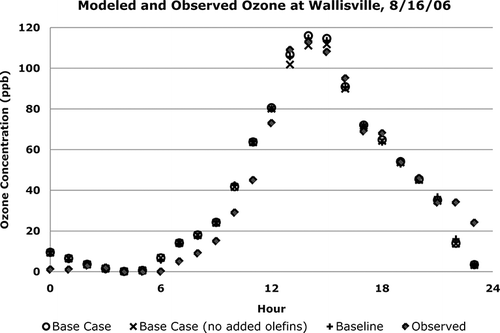LETTERS TO THE EDITOR
Dr. Editor,
This letter is in response to the paper by Vizuete et al., entitled “Issues with Ozone Attainment Methodology for Houston, TX” (J. Air & Waste Manage. Assoc. 2011, 61, 238–253).
Modeling staff at the Texas Commission on Environmental Quality (TCEQ) read the above-referenced paper with interest, and have a number of issues with the paper as published. First, the authors claim that the 2010 Houston-Galveston-Brazoria (HGB) State Implementation Plan (SIP) revisionCitation1 is “the first application in Texas of the new 8-hr attainment methodology developed by the U.S. Environmental Protection Agency's (EPA).” In fact, Texas has used this approach successfully in several SIP revisions, including the 2004 Beaumont-Port Arthur Ozone Attainment Demonstration,Citation2 the 2007 Dallas-Fort Worth Attainment Demonstration,Citation3 and (as weight-of-evidence) in the 2004 Houston-Galveston-Brazoria Ozone Attainment Demonstration.Citation4
Second, the authors discuss the progress that the HGB area has made in improving air quality since 2000, but focus only on the short-term emission limit for highly-reactive volatile organic compounds (HRVOCs) when discussing the reasons for the remarkable improvements seen since 2000. The authors fail to mention two major controls, which may be equally or more responsible for this turnaroundCitation1: mass emissions cap-and-trade (MECT), which required reductions of nearly 80% to nitrogen oxides emissions from industrial sources in the HGB Eight-County Nonattainment Area by 2006; andCitation2 HRVOC emissions cap-and-trade (HECT), which established annual emission limits of HRVOC emissions in Harris County and required continuous monitoring for most major HRVOC sources. These initiatives undoubtedly share major roles in the area's success, along with short-term HRVOC emission limits, motor vehicle emission reductions, and other programs.
Third, the authors blame the model's inability to reproduce some of the highest observed ozone increases on EPA's recommended replacement of a “base case” modeling emissions inventory with a “baseline” inventory, stating that their data “suggest that the averaging methodology and modifications to the emissions inventory have succeeded in creating model predictions of gradual increases in ozone concentrations without sharp gradients.” They therefore suggest that the model would reproduce these sharp gradients had the base case modeling inventory been used instead of the baseline, but that is simply not the case. The most temporally-resolved modeling episode used in the HGB attainment demonstration, called AQS-1 (August 15-September 14, 2006), includes hourly HRVOC emissions from scores of sources equipped with continuous monitors required by the aforementioned HECT rules. The AQS-1 inventory represents a large commitment of resources by TCEQ to collect, quality-assure, and incorporate these data into the base case, and represents TCEQ's best effort to capture the temporal variability of HRVOC emissions.Citation5 To assess to what extent the use of the baseline inventory dampened the model's ability to reproduce very rapid changes in ozone concentrations, we created two graphs in the style of the authors’ Figure 5 (see and published with this letter).
Figure 1. (a) Base case and (b) baseline modeled one hour ozone change vs. resulting ozone concentration, August 15-September 14, 2006.
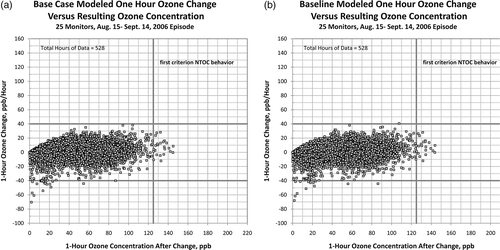
Clearly, the two figures are quite similar; indicating that replacing a temporally highly-resolved base case inventory with a baseline is probably not a major factor causing the model to fail to reproduce the most rapid ozone concentration changes. The true cause could be unreported or under-reported emission events (which obviously cannot be included in the base case or baseline), microscale meteorological events (e.g., the land-sea breeze onset) that are not precisely represented in a mesoscale model, or any of a multitude of modeling assumptions. Most likely, the cause is a combination of several factors, but there seems to be little evidence to suggest that using a baseline inventory plays much of a role.
Fourth, the authors refer to the “8-hr resultant vector” repeatedly, and then use these vectors to infer source-receptor relationships. But the resultant vector is a vector sum, which is the result of placing the component vectors head-to-tail. The 8-hr resultant is thus the vector stretching from the tail of the first component to the head of the eighth component. It ends at the end of the eighth hour, and should be placed there instead of at the end of the fourth hour on figures like the authors’ Figure 4 (the vector shown on the plots is actually the resultant divided by 8). More importantly, the resultant is not representative of any hour besides the last, and in particular is not representative of the hour when the largest ozone increase occurred (unless it occurred in the final hour). For example, a cursory examination of the authors’ Figure 4(a) shows that the winds preceding the rapid ozone rise, which occurred between hours 10 and 12, were from the west to southwest, while the “8-hr resultant” points almost due north. So the likely origin of the pollutants responsible for the rapid ozone increase at Wallisville (WALV) is to the west, not the south as the resultant suggests. We must conclude that assertions such as “As shown in the resultant wind vectors for WALV in , the transport of high O3 from the south occurs for every 8-hr O3 concentration used in the DVm calculation” [note: the authors use DVm to represent the monitored design value at a monitor] are not credible.
Fifth, the authors advocate using the “non-typical ozone change” (NTOC) criteria to “separate out those days and monitors that are better suited to be controlled by enforcement, or expansion of the existing short-term HRVOC rule, and to remove them from the DVm calculation.” This statement presupposes that all NTOCs can be eliminated through additional short-term HRVOC controls. While some NTOC-type events have indeed been linked to specific releases of HRVOCs, there is no evidence to support treating all such events as being event-driven. The close association between flow-reversals and NTOCsCitation6–8 suggests that meteorology may in fact be the dominant factor in determining the occurrence of NTOCs. Additionally, there are some NTOC days that the photochemical model replicates fairly well, such as the one that occurred at Wallisville on August 16, 2006 (see published with this letter). Three model runs are plotted against observations (i.e., base case with HRVOC emission reconciliationCitation9; base case without HRVOC reconciliation; and baseline) and although the model did not quite capture the more than 60 parts per billion ozone increase recorded between hours 11 and 13, overall it replicates the observed ozone pattern fairly faithfully, even when the baseline inventory is used. Unless a more in-depth analysis were to show the good performance resulted from compensating errors, it seems unlikely that EPA would agree to the exclusion of days such as this from design value calculations simply because the day met one of the NTOC criteria.
Rather than arbitrarily excluding some days from the DVm calculation based solely on measured ozone concentrations, TCEQ believes that it is important to examine all of the factors leading to the event and their interrelationships, and to compare the actual event to its representation by the model. Only then, would it be appropriate to assign labels to specific days and consider whether or not they should be candidates for exclusion.
Finally, it should be noted that the authors suggest removing certain days from the DVm calculation itself. Such an action would have repercussions far beyond attainment demonstration SIPs, since the monitored design value is the basis for designating an area as attainment or nonattainment, and for classification of nonattainment areas as “marginal,” “moderate,” and so forth. This would likely meet with stiff resistance from EPA and environmental groups who would be concerned that other areas might use this precedent to justify removing days from their DVm calculations.
James H. Smith
Senior Scientist, Air Quality Division, Texas
Commission on Environmental Quality
RESPONSE FROM THE AUTHORS
Dear Editor,
We would like to thank the staff of the Texas Commission on Environmental Quality (TCEQ) for taking the time to review the article and to comment.
First, we agree with TCEQ’s conclusion that the non-typical ozone change (NTOC) metric is not sufficient to establish an association with an emission event. Finding a cause for observed NTOCs is an open research question, and the lack of data on observed emission events is a significant challenge to these efforts. There is little evidence that meteorology alone, without an emission event, can produce a narrow plume of high ozone that spans only a few kilometers. We agree with TCEQ, and have also reported,1 that a particular set of meteorology is a necessary condition for an ozone violation. This meteorological condition alone, however, is not sufficient for producing a NTOC over a limited set of monitors. We report in the paper that when substantial hourly changes in measured ozone concentrations occur, they significantly impact the U.S. Environmental Protection Agency’s (EPA) definition of an 8-hr violation. Thus, it is critical to understand the cause of these observed phenomena, and evaluate whether the cause is represented in regulatory modeling.
Figure C1. Observed 1-hr and maximum 8-hr (line) ozone concentrations measured at three monitors on September 7, 2006. Arrows indicate 1-hr resultant wind vectors. The lower right is a map of Houston with the locations of the monitors.
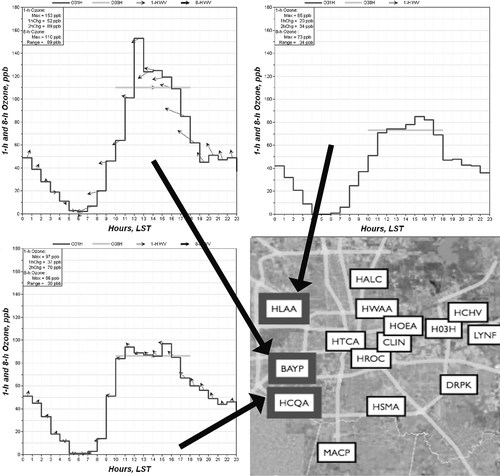
As we described in the paper, the observed NTOC phenomena occur over a small spatial scale affecting only one or two monitors, and completely miss monitors only a few kilometers away. For example, on September 7, 2006, a NTOC was observed at the BaylandPark (BAYP) monitor at hour 11 LST, as shown in (published with this letter). On the same day neither the Lang (HLAA) monitor 15 km to the north, nor the Croquet (HCQA) 8 km to the south of the BAYP showed any sign of NTOC phenomena, suggesting an ozone plume with a limited spatial scale. As shown in Figures 6 and 7 of the published paper, courtesy of the TCEQ, examination of monitors upwind of observed NTOC monitors at hours before often show a increasing narrow plume of ozone initially starting near the eastern side of Houston where intense sources and users of highly-reactive volatile organic compounds (HRVOCs) are located. As shown in Table 3 of the published paper, this case at BAYP was the third highest annual 8-hr ozone; our full analysis showed that 57% of the days that determine the critical monitor design value for the base year met the NTOC criteria.
Figure C2. (a) Observed and (b) modeled 1-hr and maximum 8-hr (line) ozone at Bayland Park (BAYP) monitor for September 7, 2006. Small hourly arrows are resultant wind observed and modeled at site each hour.
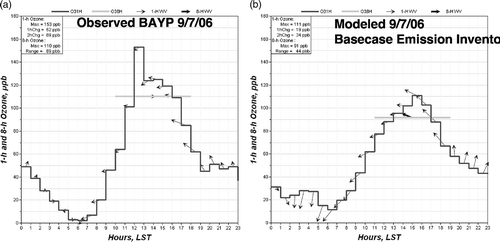
If NTOCs are the result of a random emission event, then it is a challenge with a deterministic emission inventory to predict this phenomenon accurately. Only when reported events are added in, or through insertion of plausible sources at plausible locations, is the model able to reproduce NTOC behavior. When we applied TCEQ’s base case and baseline inventories in our modeling analysis neither could reproduce the limited spatial scale, and sometimes the rate of rise of this important observed phenomenon. For example, as shown in (published with this letter), on September 7, the regulatory air quality model (AQM) was unable to reproduce this critical behavior that was observed at the BAYP monitor with either the base case or baseline emission inventory. As shown in , the AQM with the base case emission inventory predicted at the monitor a gradual increase of ozone with a maximum 1-hr change of 19 parts per billion (ppb), whereas the observed maximum change was 52 ppb.
Figure C3. Ozone time series measured at the (a) Deer Park (DRPK) monitor and (b) predicted by the regulatory air quality model using the base case emission inventory. Arrows indicate 1-hr resultant wind vectors, the straight line the 8-hr maximum ozone concentrations.
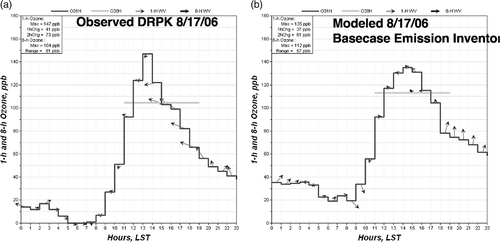
Figure C4. Plot (a) shows for the base case emission inventory, the 1-hr ozone predicted cell-by-cell for 1400 -1500 LST on August 17, 2006. The small diamonds mark monitor sites, but their shading represents observed ozone for the same time and on the same scale. The region shown in black is predicted to be above 120 ppb. Plot (b) shows the observed and predicted 1-hr ozone at each monitor site within the black area of (a). Only two close together monitors reported ozone [H11022]120 ppb, but the model predicted that all monitors over the large region, including those below 85 ppb, were experiencing close to 140 ppb of 1-hr ozone. This model prediction fails the criteria of “spatially-limited, high ozone” associated with monitor-based NTOC phenomena described in our paper.
![Figure C4. Plot (a) shows for the base case emission inventory, the 1-hr ozone predicted cell-by-cell for 1400 -1500 LST on August 17, 2006. The small diamonds mark monitor sites, but their shading represents observed ozone for the same time and on the same scale. The region shown in black is predicted to be above 120 ppb. Plot (b) shows the observed and predicted 1-hr ozone at each monitor site within the black area of (a). Only two close together monitors reported ozone [H11022]120 ppb, but the model predicted that all monitors over the large region, including those below 85 ppb, were experiencing close to 140 ppb of 1-hr ozone. This model prediction fails the criteria of “spatially-limited, high ozone” associated with monitor-based NTOC phenomena described in our paper.](/cms/asset/da55d470-1f79-4bf2-9751-a225f173a7b6/uawm_a_10412124_o_f0006g.gif)
We have found that when the regulatory AQM does make a prediction that meets some of the NTOC criteria at a monitor, it does so over a large spatial area and does not reproduce the observed limited spatial scale of high ozone seen in monitor measurements. This was a necessary condition for all cases we examined and reported in Table 3 of the published paper. For example, (published with this letter) shows that on August 17, 2006, the model predicted similar changes in hourly concentrations and nearly matches the peak 1-hr ozone measured at the Deer Park (DRPK) monitor. What we have found, though, is that the model does not reproduce the narrow spatial extent of high ozone as observed by the monitors. As shown in (published with this letter), the model predicts a high ozone plume in the southern part of the Houston urban core causing an overprediction at the majority of the monitors in that region. Although the model predictions match peak measurements at the Park Place (PARK) and Monroe (HSMA) monitors, the model over-predicts ozone concentrations by more than 40 ppb at the Westhollow (SHWH) monitor. On this day, the model is able to reproduce observed phenomena at one monitor, but does so over too large aspatial extent. For many of the days where an observed NTOC is measured at a monitor, the model does not reproduce the hourly values, or the limited spatial extent of the observed high ozone.
These data show that the model can make high ozone, but the causes of this in the model are likely not the same causes for producing high ozone in the observations. The cause of highest ozone in the observations is spatially and temporally limited, and not like the predicted ozone. We agree with TCEQ that further investigation is needed to understand and evaluate the regulatory model’s ability to reproduce NTOC behavior, and we are preparing a manuscript addressing this very question. Only then can we have confidence for future success in both the real and modeled world.
In their letter, TCEQ states that the removal of certain days from the design value (DV) calculation would receive “stiff resistance” from EPA. In the 2004 “Revisions to the State Implementation Plan (SIP) for the Control of Ozone Air Pollution, Attainment Demonstration for the Houston/ Galveston/Brazoria Ozone Nonattainment Area” document, TCEQ proposed an alternative DV to address short-term emission events (Section 1.6.4). This document further states, in Section 3.9.5: “The influence from short-term releases must be removed from the area’s design value to determine whether the model is adequately simulating the routine urban ozone formation in the base case. The model would perform adequately if the simulated ozone peak concentrations were consistent with this alternate design value.”
EPA accepted this document and the rationale for an alternative DV. Thus, for this latest attainment demonstration an alternative DV could be a plausible way forward if more evidence of the cause of observed NTOCs could be associated with short-term emission releases. This was beyond the scope of the published paper; this line of investigation is currently being pursued. Furthermore, the highly stochastic nature of HRVOC emission events suggest that capturing these for an inventory, even with extensive reporting by sources, is unlikely and that an alternative to the deterministic average modeling approach may be needed. The successful “two ozone causes” approach described by TCEQ in its 2004 SIP could be a useful alternative to apply in these current efforts.
William Vizuete
Assistant Professor
University of North Carolina at Chapel Hill
REFERENCES
- Revisions to the State Implementation Plan for the Control of Ozone Air Pollution, Houston-Galveston-Brazoria 1997 Eight-Hour Ozone Standard Nonattainment Area; Texas Commission on Environmental Quality http://www.tceq.texas.gov/implementation/air/sip/HGB_eight_hour.html (http://www.tceq.texas.gov/implementation/air/sip/HGB_eight_hour.html) (Accessed: 10 March 2010 ).
- Revisions to the State Implementation Plan for the Control of Ozone Air Pollution, Attainment Demonstration for the Beaumont/Port Arthur Ozone Nonattainment Area; Texas Commission on Environmental Quality http://www.tceq.texas.gov/implementation/air/sip/oct2004bpa_rop_ad.html (http://www.tceq.texas.gov/implementation/air/sip/oct2004bpa_rop_ad.html) (Accessed: 27 October 2004 ).
- Revisions to the State Implementation Plan for the Control of Ozone Air Pollution, Dallas-Fort Worth Eight-Hour Ozone Nonattainment Area Attainment Demonstration; Texas Commission on Environmental Quality http://www.tceq.texas.gov/implementation/air/sip/dfw_revisions.html (http://www.tceq.texas.gov/implementation/air/sip/dfw_revisions.html) (Accessed: 23 May 2007 ).
- Revisions to the State Implementation Plan for the Control of Ozone Air Pollution, Attainment Demonstration for the Houston/Galveston/Brazoria Ozone Nonattainment Area; Texas Commission on Environmental Quality http://www.tceq.texas.gov/implementation/air/sip/dec2004hgb_mcr.html (http://www.tceq.texas.gov/implementation/air/sip/dec2004hgb_mcr.html) (Accessed: 1 December 2004 ).
- Note: In addition to the Special Inventory, TCEQ staff also considered the incorporation of emission event data captured by the commission's Consolidated Compliance and Enforcement Database System (CCEDS), but ultimately did not include these data in the modeling because the events were difficult to quantify, were somewhat duplicative of the Special Inventory, and most importantly, did not make a sufficient difference in the modeling to justify their incorporation [TCEQ, 2010].
- 6. Senff, C.J.; Banta, R.M.; Darby, L.S.; Alvarez, R.J.; Sandberg, S.P.; Hard-esty, R.M.; Angevine, W.M.; Ryerson, T.B.; West, B.P. Horizontal and Vertical Distribution of Ozone in the Houston Area during the 8/29–9/6/ 2000 Pollution Episode. Presented at the American Meteorological Society's Fourth Conference on Atmospheric Chemistry, Orlando, FL http://ams.confex.com/ams/annual2002/techprogram/paper_32592.htm (http://ams.confex.com/ams/annual2002/techprogram/paper_32592.htm) (Accessed: 12–14Jan2002 ).
- Banta , R. , Senff , C. , Nielsen-Gammon , J. , Darby , L. , Ryerson , T. , Alvarez , R. , Sandberg , P. , Williams , E. and Trainer , M. 2005 . A Bad Air Day in Houston . Bull. Am. Meteor. Soc. , 86 : 657 – 669 .
- Cowling, et al. Final Rapid Science Synthesis Report: Findings from the Second Texas Air Quality Study (TexAQS II); Texas Commission on Environmental Quality http://www.tceq.texas.gov/assets/public/implementation/air/texaqs/doc/rsst_final_report.pdf (http://www.tceq.texas.gov/assets/public/implementation/air/texaqs/doc/rsst_final_report.pdf) (Accessed: 2007 ).
- Revisions to the State Implementation Plan for the Control of Ozone Air Pollution, Houston-Galveston-Brazoria 1997 Eight-Hour Ozone Standard Non-attainment Area; Texas Commission on Environmental Quality http://www.tceq.texas.gov/assets/public/implementation/air/sip/hgb/hgb_sip_2009/09017SIP_ado_Appendix_B.pdf (http://www.tceq.texas.gov/assets/public/implementation/air/sip/hgb/hgb_sip_2009/09017SIP_ado_Appendix_B.pdf) (Accessed: 10 March 2010 ).
